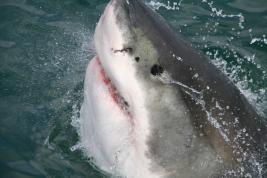
After more than 12 days of no sharks sightings in Gansbaai, two juvenile sharks were spotted by the Marine Dynamics team on Sunday 17 January.
According to their blog, Marine Dynamics did not take any clients out for shark diving for the previous 12 days, as the team could not give the white shark experience they usually strive for.
Alison Towner, Dyer Island Conservation Trust senior biologist and a PhD student at the University of Rhodes, gives the following possible reasons for the great white shark scarcity on her blog:
On 1 January, after an incredible December, white shark sightings began to slow down in Gansbaai. Cage diving operators are returning from sea reporting no sightings of white sharks despite extensive attempts to find them, for over a week.
There are eight companies each trying different parts of the bay daily. Speculative statements get thrown about whenever drops in the shark’s numbers occur. Therefore, we have attempted to address some real possibilities.
Seasonality: December, January and February are generally quieter months in terms of white shark numbers in Gansbaai. Even though viewing is possible year round the overall number of sightings per trip is usually the lowest. Tagging and boat based data show there are less white sharks around in Western Cape waters, particularly late Summer.
Migration: From satellite tracking data we now know that the majority of white sharks sighted in Gansbaai and other Western Cape aggregation sites such as Mossel Bay and False Bay migrate along the east coast in summer, as far as Mozambique, Madagascar and even across to the Seychelles and Kenya.
The Tugela banks and Mozambique channel offer incredibly rich prey species diversity for white sharks – large game fish such as sailfish, marlin and kingfish peak in numbers and breed at this time of year.
Environmental conditions: We are currently in the middle of a major ‘El Nino’ event, just looking at the floods in Europe and droughts elsewhere one can see that climate conditions are abnormal. As a result, ocean temperatures are warmer along many coasts. This may well alter the prey species distribution for white sharks and thus they follow them into other areas. Recently sun fish, trevally and various other warm water species were reported in Gansbaai. We know the strength of climatic phase varies, which may influence white shark numbers and sexual composition significantly. Warmer water temperatures may be preferentially selected by female white sharks due to higher growth rate demands for breeding. Also rapid drops in water temperature can be thermally stressful for many species, in the space of three days sea surface temperature dropped from 19 °C to 11 °C in Gansbaai!
Deceased whales: If a whale carcass washes up or is nearby the area then white sharks may well be attracted to it from miles away. There have been deceased whale carcasses recorded in the Western Cape the last few weeks, including a rare sperm whale and three humpback whales in Cape Town.
Trauma induced departure/flight response: It has been recorded in California, New Zealand and South Australia that when a white shark is killed, often others in the area will pick up the bio chemical signal from the rotting carcass, which usually sinks, causing them to leave the area.
An observation was made that a white shark was hit in Gansbaai by a Trans Agulhas racing boat this December, while the animal was basking at the surface. This was observed by a skipper on one of the vessels who reported it immediately. Although no white shark carcass was confirmed after the strike, we know that previously documented boat propeller injuries have killed white sharks.
Pods of transient orcas have been observed more frequently between Cape Town and Agulhas over the last few years and may cause a flight response in white sharks.
Inevitably, white sharks are highly migratory top order predators. They do not live for extensive time periods in coastal areas. These regions provide seasonal rest and refuel pit stops for them. They are certainly not resident animals conditioned into an area for us to dive with. The species is driven by a complex array of factors and cues which will also vary depending on the shark’s age and gender.
Even though cage diving eco tourism in Gansbaai can usually offer diving with this species on inshore reefs in summer months, it must still be appreciated that these are migratory unpredictable animals – their presence can never be guaranteed although some times of the year are simply better than others.
Photo: Marine Dynamics
Source: http://www.netwerk24.com/ZA/Hermanus-Times/Nuus/the-shark-shortage-explained-20160120-2
